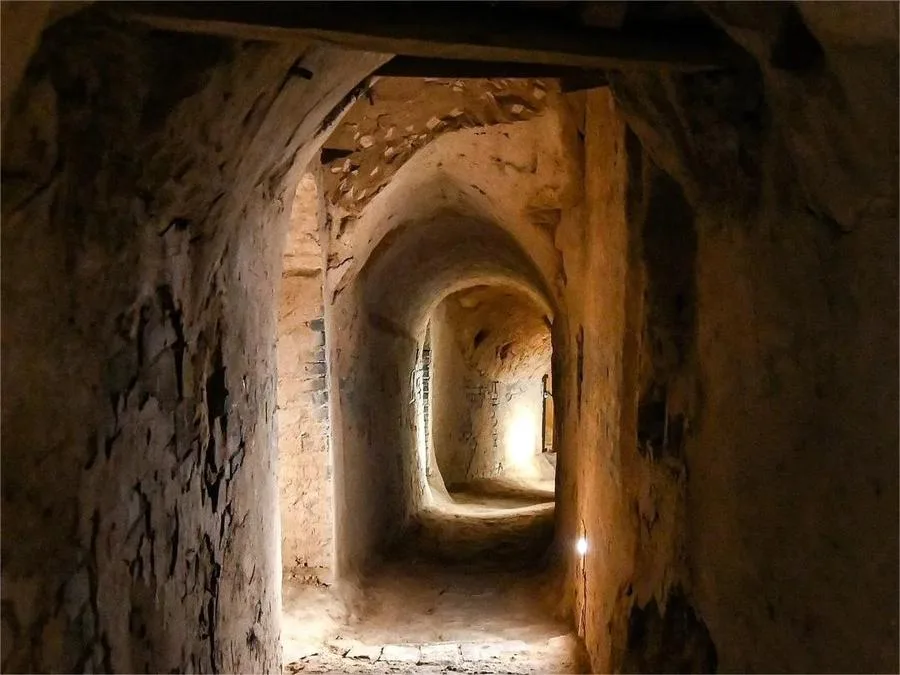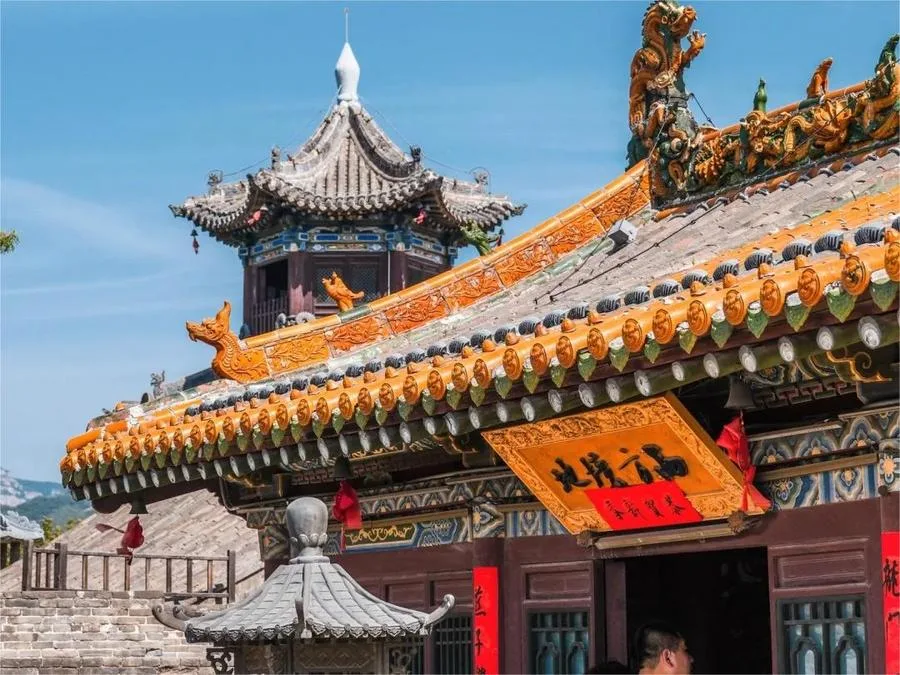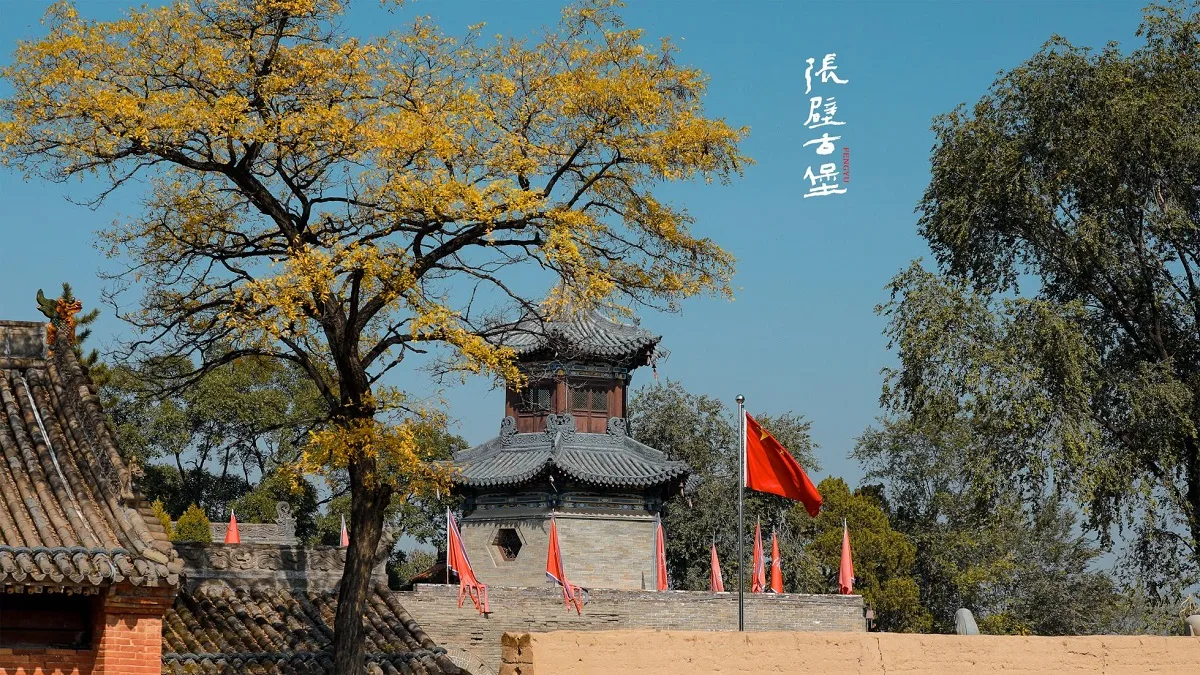Zhangbi Ancient Castle (张壁古堡), also known as Zhangbi Village, is located in Jiexiu City, Shanxi Province. Established during the Sixteen Kingdoms period (345-356 AD), the castle measures 374 meters from east to west and 244 meters from north to south, with a perimeter of 1,300 meters and a building area of 12,000 square meters. The walls of the castle, built with rammed earth and reinforced over time, stand about 5 to 7 meters high, with significant reconstructions dating from the Tang to the Ming and Qing dynasties. Perched on a ridge and flanked by gullies, the castle’s south side is higher than the north, making it a strategically advantageous location that is easy to defend and offers retreat routes.
The design of Zhangbi Ancient Castle adheres to traditional Chinese principles of astronomy and geomancy, featuring elements of Yin and Yang, the Five Elements, and the Liu Ren mystical gates. Numerous structures have been discovered to correspond with constellations. The name “Zhangbi” is derived from two of the twenty-eight constellations: “Zhang” and “Bi.”
The castle has two gates: the north gate and the south gate. The north gate, built with bricks, is fortified by an outer barbican with several religious temples on top. The entrance of the barbican faces slightly northeast, aligning with the north gate, creating a dual-gate system. This alignment not only follows ancient military defense principles but also symbolizes the containment of good fortune within the castle. The entrance points towards a small hill 800 meters away, known as “Zhaobi,” with seven locust trees representing the Big Dipper constellation.
The south gate, made of stone, features a carved dragon head symbolizing the dragon’s head. Outside the gate, nine red stone paths represent the dragon’s whiskers. Inside the castle, a 300-meter-long stone-paved street connects the north and south gates, symbolizing the dragon’s body. During the Qing dynasty, residents, considering feng shui and the flourishing of literary endeavors, replaced the central blue stone slabs of the street with three parallel rows of long red stone strips, extending from the south gate to the north gate, symbolizing the dragon’s spine. The castle’s layout is well-organized with distinct main and secondary streets, exquisite doorways, and well-preserved brick, wood, and stone carvings.
Table of Contents
- Basic Information
- Location and Transportation
- Highlights of Zhangbi Ancient Castle
- Vlog about Zhangbi Ancient Castle
- The Origin of Zhangbi Ancient Castle
- Other Attractions in Jiexiu City
Basic Information
| Estimated Length of Tour | Half a day |
| Ticket Price | 75 RMB |
| Opening Hours | 8.00 – 16.50 |
| Telephone Number | 0086-400-116-1600 |
Location and Transportation
Zhangbi Ancient Castle is located in Zhangbi Village, Longfeng Town, Jiexiu City, Jinzhong, Shanxi Province, about 15 kilometers from the Jiexiu city center. To get there, you can take bus route 301 from Jiexiu to the Zhangbi Ancient Castle Scenic Area stop and then walk to the castle.
Highlights of Zhangbi Ancient Castle
Extensive Tunnels

The tunnels of Zhangbi Ancient Castle lie beneath the entire village. Due to multiple earthquakes, most of the tunnels have collapsed, with only about 1,000 meters cleared and accessible, representing just one-tenth of the original system. The tunnels are divided into three levels: the upper, middle, and lower layers. The uppermost layer is approximately 1 meter below the surface, the middle layer is 8 to 10 meters deep, and the lowest layer is 17 to 20 meters deep. Among these, there is an S-shaped tunnel with a network structure, connecting extensively with the surface fortress.
Within the tunnels, six wells have been discovered, each with holes or doorways in the well walls. The holes allow water to be drawn up using ropes and buckets, while the doorways provide access to other passages by placing wooden planks. Small holes in the tunnel walls facilitate air circulation with the outside world. Additionally, small pits in the walls, supposedly used for placing oil lamps, appear at regular intervals. Lower down the walls, there are niches every so often that can accommodate two or three people, serving as lookout posts. The lowest level contains larger cavities, 2 to 3 meters wide and 4 to 5 meters long, used for storing grain.
Every detail of these tunnels reflects meticulous military thinking, evident in the intersecting layout, strategic positions for attacking and monitoring enemies, and provisions for survival and communication.
Khan Temple

The Khan Temple is the main structure within the temple complex near the southern gate of Zhangbi Village. It is situated on a high loess platform on the eastern side of the village. The temple measures 57 meters from north to south and 28 meters from east to west, surrounded by a parapet wall. The southern edge protrudes beyond the castle wall, while the northern edge borders Da Dong Alley, with a height of 8 meters, making it the highest point in Zhangbi Village. The high crenellated walls of the Khan Temple create the appearance of a fortress within a fortress.
The temple courtyard is divided into three levels, with a square area of more than 20 meters on each side. The east and west sides of the courtyard are flanked by side rooms, while the main hall and the bell and drum towers stand on a platform over 2 meters high on the northern side. The main hall has three bays, with a frontage of 10 meters. It features straight lattice windows and paneled doors, a simple structure with four purlins and three rafters, lacking bracket sets, and a gabled roof.
The eaves of the main hall include “lip tiles,” which have been identified by epigraphist and archaeologist Zhang Han as Song dynasty works known as “Yizhi Mei” (One Eyebrow). Architectural historian Luo Zhewen has dated the tiles to the Song-Liao period and referred to them as “decorative edge tiles.” The glazed ridge tube of the roof was replaced with gray pottery ridge beasts during a Yuan dynasty reconstruction. The central ridge is adorned with golden yellow glazed ornaments, although the exact period of these decorations is unknown.
Kongwang Xingci Temple

The Kongwang Xingci Temple was renovated in the 41st year of the Wanli period of the Ming Dynasty (1613). The main hall faces south and houses a statue of Kongwang Buddha. The gable walls are adorned with murals depicting the story of Kongwang Buddha’s enlightenment. The hall’s roof features delicate and finely crafted Ming Dynasty tri-colored glazed decorations, renowned for their realistic and exquisite workmanship.
In addition, there are two rare glazed steles under the front porch of the Kongwang Buddha Palace. The eastern stele recounts the arduous journey of Kongwang Buddha’s cultivation and enlightenment, while the western stele details the construction process of the Kongwang Buddha Palace.
Other Structures

Zhangbi Ancient Castle retains the traditional Chinese “Lifang” layout, which has disappeared from most ancient cities in China. The alley gates and gatehouses are well-equipped, and when closed and locked, they create a fortress within a fortress. Currently, there are over 30 well-preserved courtyards in the castle, with residential houses neatly arranged and maintaining a certain distance from the city walls. The main entrances of the houses and alleys are elevated with steps, ensuring they are spacious and south-facing.
The western four alleys are predominantly occupied by wealthy families with surnames Zhang, Wang, Jia, and Jin. These residences feature exquisite door lintels and intricate brick, wood, and stone carvings, often depicting popular and auspicious motifs such as lions playing with embroidered balls, magpies on plum blossoms, and cranes and deer heralding spring.
Vlog about Zhangbi Ancient Castle
The Origin of Zhangbi Ancient Castle
There are four main persuasive theories about the origin of Zhangbi Ancient Castle:
Connection to General Zhang Ping: One theory suggests that Zhangbi is related to the fortress built by General Zhang Ping of the Later Zhao during the Sixteen Kingdoms period. Amid the chaos following the migration of the Jin dynasty to the south, local powerful families organized to protect themselves, and building fortresses was a primary method. Zhang Ping, active in areas like Yanmen, Xihe, Taiyuan, Shangdang, Shangjun, and Hedong, is speculated to have a direct connection to Zhangbi. Scholars estimate that Zhangbi might have been constructed between the first year of Yonghe and the fifth year of Shengping (345-356 AD). Although the initial construction might predate this period, it is inferred that Zhangbi was built by local elites for self-defense during the northern power vacuum following the Jin dynasty’s southward migration. This type of fortress integrated military, residential, and agricultural functions, with military roles being particularly prominent.
Nan Shuo Prefecture City: Another theory posits that Zhangbi served as the Nan Shuo Prefecture city from the Late Wei to the Zhou period. According to the Qianlong edition of “Fenzhou Fu Zhi,” Jiexiu city was built during the reign of Emperor Xiaojing of Wei to move the Shuo Prefecture’s military preparations and constructed earthen walls. The “Wei Shu: Geography Records” indicates that Jiexiu City of Western River Commandery was relocated 25 li southeast of its original site during the Northern Wei dynasty. This theory suggests that Zhangbi was the Nan Shuo Prefecture city during this period, likely around 484 AD during Emperor Xiaowen’s reign. However, due to the surrounding conditions, it was likely a temporary administrative center rather than a permanent county seat, indicating an earlier establishment.
Construction by Gao Huan: A third theory attributes the construction of Zhangbi to Gao Huan, a powerful minister of the Northern Wei and the founder of the Northern Qi dynasty, known for his expertise in tunnel building. Given that Zhangbi is filled with tunnels, this theory has some merit, though it lacks sufficient evidence and may be speculative.
Connection to Liu Wuzhou: The final theory connects Zhangbi to Liu Wuzhou, a Khan titled by the Turks during the Sui-Tang transition. According to the Jiaqing edition of “Jiexiu County Annals,” in the second year of Tang Emperor Gaozu’s reign (619 AD), Liu Wuzhou’s forces occupied Jiexiu. By the third year, Li Shimin (later Emperor Taizong) defeated Liu Wuzhou’s forces in multiple battles. It is suggested that within this year and a half, the construction of Zhangbi, with its extensive fortress and tunnels, was possible but lacks direct evidence, making this theory less certain.
Regardless of which theory is closer to historical fact, it is clear that Zhangbi Ancient Castle emerged as a military fortress during a specific era and regional context. Its military nature is undeniable, distinguishing it from later fortresses and settlements built during the Ming and Qing periods in response to Mongolian raids or peasant uprisings.





We went through the underground passage at 5 PM, and most people had already left. It felt a bit eerie due to the vastness, but it was a unique experience nonetheless. It’s about a half-hour drive from the city center and also very close to Mianshan Mountain. I highly recommend visiting this place!
Long, tedious, and slightly eerie; the authentic experience seems endless.
At night, the Zhangbi Ancient Castle is beautifully illuminated. The ancient city walls appear even more mysterious under the lights, as if they are telling stories that have lingered for a thousand years.
The Zhangbi Ancient Castle is home to exquisite small temples from the Ming and Qing dynasties, with beautiful glazed tiles and murals that are certainly noteworthy. However, beyond these attractions, most areas seem to be commercial spaces operated for profit by private owners. During the winter, Zhangbi Ancient Castle is quite desolate and cold, with very few visitors around. I initially hoped to join a tour and listen to some explanations, but that turned out to be quite difficult. Most… Read more »
The village itself isn’t particularly special, but the ancient underground tunnel, which is said to be over 10,000 meters long, is indeed quite rare.
There are fewer tourists here, and it feels like the promotion isn’t very adequate. However, I am tired of crowded places filled with people; I actually prefer this sense of tranquility.